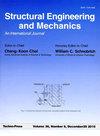Effect of medium coarse aggregate on fracture properties of ultra high strength concrete
IF 2.2
4区 工程技术
Q2 ENGINEERING, CIVIL
引用次数: 1
Abstract
Ultra high strength concrete (UHSC) originally proposed by Richards and Cheyrezy (1995) composed of cement, silica fume, quartz sand, quartz powder, steel fibers, superplasticizer etc. Later, other ingredients such as fly ash, GGBS, metakaoline, copper slag, fine aggregate of different sizes have been added to original UHSC. In the present investigation, the combined effect of coarse aggregate (6mm – 10mm) and steel fibers (0.50%, 1.0% and 1.5%) has been studied on UHSC mixes to evaluate mechanical and fracture properties. Compressive strength, split tensile strength and modulus of elasticity were determined for the three UHSC mixes. Size dependent fracture energy was evaluated by using RILEM work of fracture and size independent fracture energy was evaluated by using (i) RILEM work of fracture with tail correction to load – deflection plot (ii) boundary effect method. The constitutive relationship between the residual stress carrying capacity (σ) and the corresponding crack opening (w) has been constructed in an inverse manner based on the concept of a non-linear hinge from the load-crack mouth opening plots of notched three-point bend beams. It was found that (i) the size independent fracture energy obtained by using above two approaches yielded similar value and (ii) tensile stress increases with the increase of % of fibers. These two fracture properties will be very much useful for the analysis of cracked concrete structural components.中粗骨料对超高强度混凝土断裂性能的影响
超高强度混凝土(UHSC)最初由Richards和Cheyrezy(1995)提出,由水泥、硅灰、石英砂、石英粉、钢纤维、高效减水剂等组成。后来在原UHSC中加入了粉煤灰、GGBS、偏高岭土、铜渣、不同粒度的细骨料等配料。本试验研究了粗骨料(6mm ~ 10mm)和钢纤维(0.50%、1.0%和1.5%)对UHSC混合料的综合作用,以评价其力学性能和断裂性能。测定了三种UHSC混合料的抗压强度、劈裂抗拉强度和弹性模量。采用裂缝的RILEM功对尺寸相关的裂缝能进行评估,采用(i)裂缝的RILEM功对载荷-挠度图进行尾修正(ii)边界效应法对尺寸无关的裂缝能进行评估。从缺口三点弯曲梁的荷载-裂缝开口图出发,基于非线性铰的概念,建立了残余应力承载能力σ与相应裂缝张开度w的逆本构关系。结果表明:(1)两种方法得到的与尺寸无关的断裂能值相近;(2)拉伸应力随纤维含量%的增加而增大。这两种断裂特性对混凝土结构构件开裂分析具有重要意义。
本文章由计算机程序翻译,如有差异,请以英文原文为准。
求助全文
约1分钟内获得全文
求助全文
来源期刊

Structural Engineering and Mechanics
工程技术-工程:机械
CiteScore
3.80
自引率
18.20%
发文量
0
审稿时长
11 months
期刊介绍:
The STRUCTURAL ENGINEERING AND MECHANICS, An International Journal, aims at: providing a major publication channel for structural engineering, wider distribution at more affordable subscription rates; faster reviewing and publication for manuscripts submitted; and a broad scope for wider participation.
The main subject of the Journal is structural engineering concerned with aspects of mechanics. Areas covered by the Journal include:
- Structural Mechanics
- Design of Civil, Building and Mechanical Structures
- Structural Optimization and Controls
- Structural Safety and Reliability
- New Structural Materials and Applications
- Effects of Wind, Earthquake and Wave Loadings on Structures
- Fluid-Structure and Soil-Structure Interactions
- AI Application and Expert Systems in Structural Engineering. Submission of papers from practicing engineers is particularly encouraged.
 求助内容:
求助内容: 应助结果提醒方式:
应助结果提醒方式:


